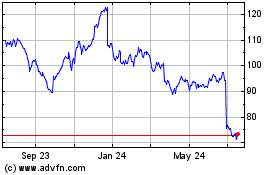Nike Revenue and Profit Rise, Though Growth in a Key Indicator Slows--2nd Update
September 27 2016 - 7:54PM
Dow Jones News
By Sara Germano
Nike Inc. reported an 8% jump in quarterly sales Tuesday, but
slowing future demand for its sneakers and apparel fanned
investors' concerns about the sportswear maker's growth
prospects.
The company said world-wide futures orders -- a calculation of
the amount of goods scheduled for delivery within the next six
months -- rose 5% for the period ending January 2017, compared with
9% growth for the same period a year ago.
In the North American region, which comprises the lion's share
of Nike's business, futures orders rose just 1% in the fiscal first
quarter, compared with 14% growth in the year-ago period. Analysts
typically have monitored futures orders as a way to measure demand
for Nike's products.
Shares of Nike fell 2% in after-hours trading to $54.19, after
ending the 4 p.m. session at $55.34.
In a significant shift, Nike finance chief Andy Campion said
Tuesday the company will no longer report futures orders in its
quarterly earnings news releases. They will instead be discussed on
a conference call with analysts and reported in regulatory filings,
he said.
"Futures orders continue to be an important and valuable aspect
of our operating model. That said, the relationship between
reported futures and reported revenue in a given quarter has become
less correlated" as the company sells more items directly to
consumers, Mr. Campion said.
The move marks not only a shift in how Nike reports its results,
but a wider change in retail. Looking to replicate the success of
fast-fashion houses such as H&M and Zara, many manufacturers
are aiming to bring products to market more quickly, and sell those
products directly to consumers, instead of through wholesale
partners.
At its investor day last fall, Nike said it hoped to more than
double its annual direct-to-consumer sales to $16 billion by
2020.
Before Tuesday's earnings report, Nike had been contending with
a rapidly changing sporting-goods industry, including the
bankruptcy and liquidation of major retail partners, including The
Sports Authority Inc., among others.
Nike also has been facing increasing pressure from rivals Under
Armour Inc. and Adidas AG in its domestic market. Analysts have
noted both companies have grabbed market share from Nike, the
overall leader, in crucial categories such as basketball and casual
footwear.
Nike Chief Executive Mark Parker acknowledged the company has
faced stiffer competition from upstart competitors, as the athletic
look has influenced apparel and footwear styles.
While this summer featured two premier sports events in the
Olympic Games and the European soccer championship, "the look of
sport continues to influence everyday styles around the world. As a
result, new brands are entering into the athletic landscape," Mr.
Parker said.
Mr. Campion said North American sales should outpace futures
orders growth in the region for the balance of the year, as Nike
expects stronger sell-through to consumers.
In the first quarter, Nike's revenue was $9.06 billion as North
American sales grew 6.1% to $4.03 billion. Overall, Nike reported a
profit of $1.25 billion, or 73 cents a share, up from $1.18
billion, or 67 cents a share, a year earlier. Analysts had expected
per-share profit of 56 cents.
--Tess Stynes contributed to this article.
Write to Tess Stynes at tess.stynes@wsj.com
(END) Dow Jones Newswires
September 27, 2016 19:39 ET (23:39 GMT)
Copyright (c) 2016 Dow Jones & Company, Inc.
Nike (NYSE:NKE)
Historical Stock Chart
From Mar 2024 to Apr 2024

Nike (NYSE:NKE)
Historical Stock Chart
From Apr 2023 to Apr 2024
